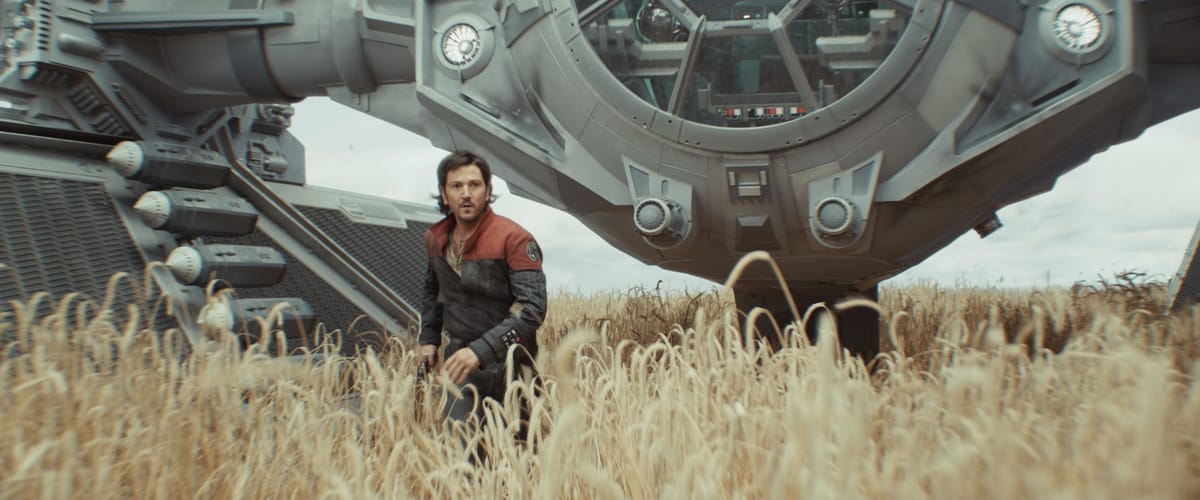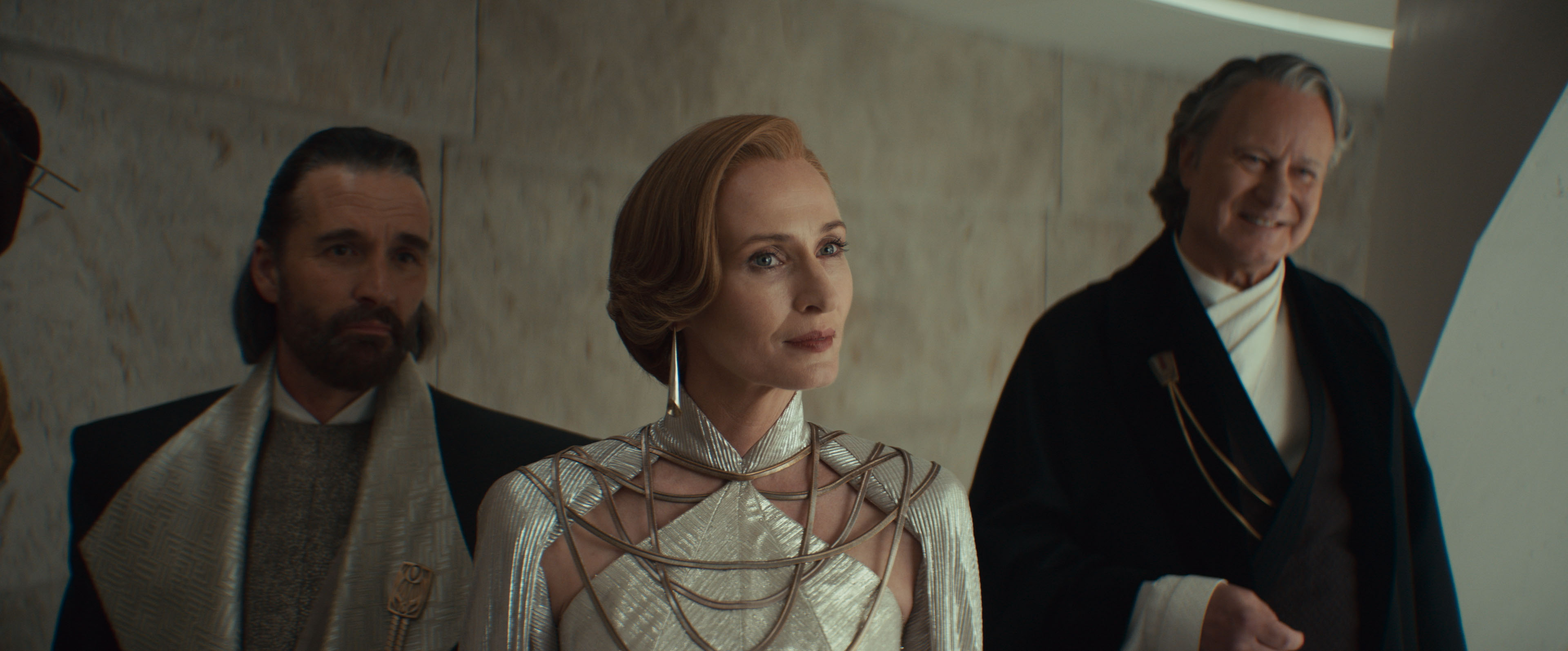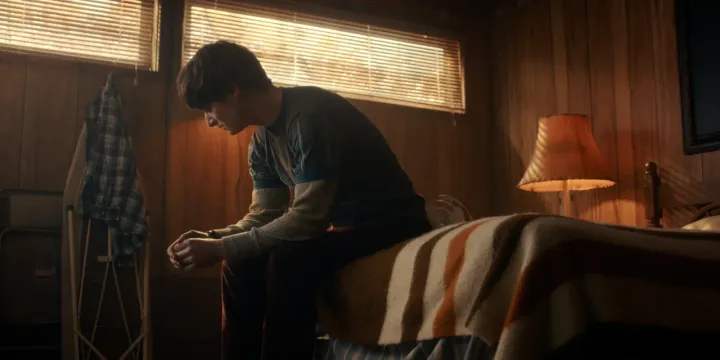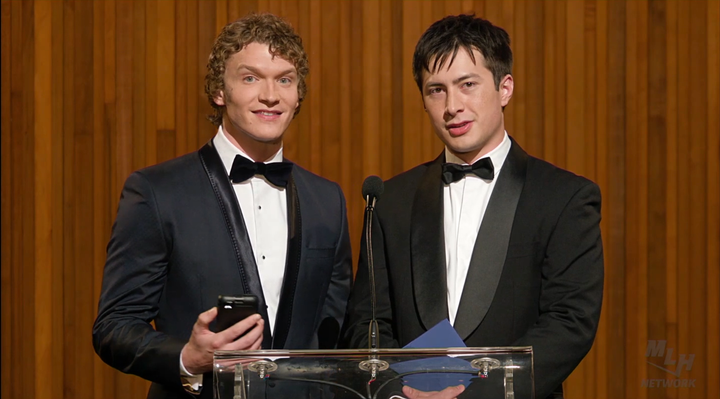Review: Andor, "One Year Later," "Sagrona Teema," & "Harvest" | Season 2, Episodes 1, 2, & 3
Who else has fond memories of being raised in an Imperial Kinder-block?

Welcome to Episodic Medium’s coverage of the second and final season of Andor, the latest installment in Disney+’s expansion of the Star Wars universe. As always, this review is free for all, with subsequent reviews exclusively for paid subscribers. For more information on our schedule for the rest of the year and what your subscription gets you, check out our About Page for more information.
“If I die tonight, was it worth it?”
We are fast approaching a decade since the release of Star Wars: The Force Awakens, the first Disney-owned and produced film in the vast galaxy far, far away, and so it becomes almost necessary to take stock of what this franchise has become in that period. Ten years prior to the film that would introduce us to Rey, Finn, Poe Dameron, and others, Lucasfilm unveiled the final film in the prequel trilogy that helpfully explained how Anakin Skywalker morphed into Darth Vader. If you had told me two decades ago that Star Wars would be ubiquitous beyond belief (even compared to how popular the series was in 2005), I’m sure I would’ve assumed you were nuts. But Disney has managed to sustain the series’ popularity on a whole new scale, albeit in a way that has made it diffuse in a way it wasn’t before.
Most of what has come after J.J. Abrams’ 2015 film has attempted to not only fill in the gaps (perceived or otherwise) in the story we already know, but to do so in ways that don’t get too edgy. (Lucasfilm chose to learn the hard way that if you make a film like, say, The Last Jedi, some very loud people will shout about you online, and that would be very bad indeed.) Yet despite being one of the most direct spinoffs from an existing property, it’s the two-season series that fleshes out the character of Cassian Andor (Diego “Seriously, let me touch Jabba” Luna) beyond what we know of him from the 2016 film Rogue One that has managed to be the most adult, incisive, and resonant thing Lucasfilm has made in the last decade. That bar may be somewhat low to clear, but that doesn’t make it less significant.
In one of my reviews of last summer’s The Acolyte, I recalled going to a baseball game last year where one of the hometown players was being feted with a bobblehead in which he appeared as a Stormtrooper. It’s a smaller version of what you can experience at both Disneyland and Walt Disney World’s Magic Kingdom in the Galaxy’s Edge area. That part of the theme park is remarkably detailed, and effectively able to make you feel like you’re really wandering around in one of these movies—not just because of the architecture, the sight of not-in-use starships (including a massive and amazing replica of the Millennium Falcon), but also because of the Cast Members. Some of the Cast Members are playing people within the Resistance, but others are inevitably playing members of the First Order, meaning that they are, in essence, playing Space Nazis. If you wait in the queue for the superlative Rise of the Resistance, you get to see a handful of Cast Members living it up as the baddies, no doubt enjoying the fact that they get to talk to guests in a less-than-friendly way.1
But they are still playing Space Nazis, a fact that the theme parks don’t really grapple with (for understandable reasons). The sequel trilogy doesn’t exactly shy away from the ramifications of the First Order being so terrifying: in the films as in the theme-park rides, Domhnall Gleeson seems to understand the assignment down to his bone marrow, angrily chewing up the scenery as if it insulted him before he walked into frame. Yet the way that Tony Gilroy has brought Andor to life, it is clear he wants to truly grapple with the effects of a rebellion on both sides of the coin, a refreshingly adult approach to this universe.
Now, this is not to say that I am the biggest booster of Andor. Since it’s been nearly three years since the first season aired on Disney+, I rewatched the first season a couple weeks ago and also read my reviews of the first season here at the site. If you followed along with my week-to-week posts then, you will recall that my enjoyment of the show increased over time (almost akin to how Cassian himself becomes more committed to the cause by the end of the first season). The three-episode premiere felt a little too low-key for me then, but by the time Kino Loy was exhorting his fellow prisoners on Narkina 5 to rise up against their oppressors, I was almost shocked at how much I was onboard for the show. My reaction now is pretty much the same as it was then: the show has a somewhat slow start but barrels its way towards an intense climax between people on the hardscrabble planet Ferrix and the Imperial Empire.
Gilroy has not been shy about the fact that his initial vision for this show was a five-season outline, with each season covering another year that gets us closer to the Battle of Yavin (or, for those of us who are casual fans, the climactic events of the 1977 Star Wars). However, by the time the first season premiered back in 2022, Gilroy had determined that it would take too long to make the show that way (as evidenced by the lengthy gap between seasons). As is common in TV, plans change, and so the second and final season of Andor is handling things in a unique way: three episodes per week for four weeks, and each three-episode chunk covers each of the four years leading up to Yavin.
With one-quarter of the season now out of the way, I think it’s safe to say that I am torn about whether this approach will be effective. On one hand, part of the discourse in the first season was how much this show felt like a series of movies strung together (partly aided by people involved in the series saying as much). So why not lean into that further and allow people to watch each of those tied-together episodes at the same time? On the other hand, this is still split into 12 discrete installments, even if three of them are dropping at the same time. (That said, each three-episode chunk has the same writing-and-directing crew, further emphasizing the visual and thematic connectivity.)
At the very least, I am torn because I imagine each three-episode chunk may have a different emotional or thematic impact. Or maybe I just hope that, because while it’s undeniably true that the premiere episode, fittingly titled “One Year Later,” opens with an incredibly effective sequence that sets Cassian on an unexpected and fairly frustrating unplanned journey, the other plots across all three episodes are a bit of a mixed bag. As can often be the case with genre fare that pushes together a key cast of characters at the end of one season, much of this trio of installments flings those characters far apart from each other, allowing for four different general plots across the roughly 140-minute combined runtime.
Let’s start with the storyline that technically has the least impact to our heroes for now, but is no doubt going to set into motion things that lead to the Death Star’s presence in the 1977 film. Dedra Meero, as we first glimpse her, is in the Maltheen Divide as part of a super-duper-secret group brought together by Director Orson Krennic (Ben Mendelsohn, reprising his role from Rogue One). As has already been noted online, this hush-hush meeting may be about taking over a planet called Ghorman to get at its powerful minerals and equally powerful and yucky spiders, but Gilroy (who wrote all three of these episodes) is very deliberately echoing how the Nazis came together in 1942 to come up with the Final Solution of exterminating Jewish people. This scene would be chilling even if you didn’t know that specific allusion, considering how *gestures to the world at large* everything now feels like a grim echo of the recent past. But I appreciate Gilroy leaning into the unabashed, undeniable cruelty here, where even Dedra is put off by it.
She wants badly to not be involved in the “Ghorman Project,” even as her boss emphasizes that being chosen for this is a good thing that she should enjoy. Maybe she would be happier with work if her home life wasn’t so currently annoying, because guess who’s in love? Yes, in one of the most perversely delightful twists, Dedra is now living with (and…I guess in love with?) our favorite little weirdo, Syril Karn. Syril has moved up in the professional world slightly; whereas last season, he was the one being oriented to his soul-sucking new job, he’s the one now telling people how great the work is. And he’s not just dating Dedra, but they live together. While Syril’s mother is as obnoxious as ever, Dedra is the one privately telling her to butt out and leave them alone, while promising that she’ll ensure Syril will call her at pre-determined times a month. How this guy has managed to woo Dedra is one of those things we’ll presumably never know, but who knows: maybe wedding bells are in their future in one of the upcoming three-episode chunks.
And speaking of weddings (hold your applause for that seamless transition), a good chunk of these three episodes takes place on Chandrila as Mon Mothma’s daughter Leida gets married to Stekan, the son of the shady Sculdun. This, of course, follows up on the back-door deal to get money for the Rebellion. In the long run, it will help the broader cause, but Mon is having an understandably difficult time watching her daughter marry this bland louse. That’s in spite of Luthen Rael hovering on the periphery of the big ceremony and reception, largely to remind Mon of the difficult price she has to pay to ensure eventual freedom from the Empire.
There are specific grace notes of this storyline that I thought were effective, such as Mon trying to pull a Hail Mary and convince Leida to not go through with the wedding, only for Leida to tell her mom to go get drunk instead. (That would be what Mon’s own mother did when she got married.) And I also appreciated getting a brief glimpse of how Luthen is able to get key information without other parties even realize he’s pumping them for clues, as we see him hobnob throughout the reception. But much of this plot reminded me a lot of my reaction to Mon’s extremely slow-burn shift to rebelling in the first season. If nothing else, it would be nice if Mon’s shift to the character we know her as in the actual films went a bit faster (especially since we’re now jumping year to year across the next few weeks).

The issue, to be clear, is not whether it’s realistic to see people in power have a challenging time between enjoying the largesse they’re used to and fighting to escape the tyranny they face even at high levels. Just as I rewatched the first season, I re-read my reviews of those episodes, and noted in one instance a remark someone made (I think perhaps our dear overlord Myles) about how a certain plot element would have been much more painful to watch if, say, Donald Trump had won re-election in 2020. So, y’know, watching these episodes at a time when Trump did get re-elected allows for an even more emphatic connection between fiction and truth. That a person such as Mon Mothma would continue to blanche that being committed to the cause of rebellion means that you have to make hard decisions (in her case, being willing to have Luthen get rid of her old banker friend after he hits her up for more money) is disturbingly, exceedingly realistic. I am not entirely sure it’s dramatically effective, though.
Our other two major storylines focus on Cassian’s old friends Bix, Brasso, and Wilmon, as well as Cassian himself. Bix, for her part, is still understandably haunted a year later with nightmares of when the Empire tortured her for information, no matter how hard she tries to say otherwise. Even though presumably anyone who’s watched this far into Andor knows that the Empire is a terrifying group, this storyline allows us to experience what that kind of existential terror must be like on a day-to-day basis. While these folks are trying to keep to themselves, living and working on a planet called Mina-Rau, they are also undocumented and become particularly terrified when the Imperial Empire sends some officers to perform an audit for the first time in decades.
In this plot, as it plays out across the three episodes, you can see historical resonance in how people would hide fleeing Jews during World War II only to quail and give up those innocents when the Nazis came calling.2 But the resonance is nothing compared to what is arguably among the most intense and discomfiting sequences in this franchise, as the lead official attempts to rape Bix in “Harvest,” after being a disturbing little creep in the previous installment. It’s not just the depiction (courtesy of director Ariel Kleiman) of the attempted sexual assault or the ensuing messy fight that Bix fortunately escapes with her life. It’s the fact that Bix correctly identifies what happened as the Lieutenant trying to rape her, which is the kind of ugly and disturbing thing that happens too often in the real world but rarely in this fictional one. And here, unlike the Mon Mothma subplot, it’s both realistic and dramatically effective.
As I noted above, though, the absolute pinnacle of these three episodes comes at the outset of “One Year Later” with Cassian Andor himself. Kleiman and Gilroy combine for a patient but thrilling sequence, as we see Cassian working with a young Imperial mechanic (quoted up top) to break into and steal a TIE Fighter for purposes as-yet-unknown. While the initial theft works, Cassian quickly realizes that he’s at a bit of a loss with the controls of the ship since it isn’t the same as the one he trained on, leading to a wild and unexpected dogfight that he barely escapes. Andor is clearly not the show you watch if you expect huge action setpieces week after week, in part because (even here) you have the knowledge that Cassian’s going to be fine. But when the show does bust out some action, as it did last season when Luthen went head to head with the Empire, it works wonders. I do kind of wish all three of these episodes were as effective as the opening sequence, but a strong start is a strong start.
That is, sadly, more than I can say about the rest of Cassian’s storyline. Here, once again, we have a very realistic story that simply isn’t as dramatically effective. Though Cassian lands in the right place for his rendezvous with a guy named Porko, his contact is nowhere to be seen. Instead, Cassian is captured by the Maya Pei Brigade, an extremely ragtag group of would-be rebels who would be a lot better at fighting back if they would stop fighting amongst themselves. I hesitate to delve too deep into real-world politics (mostly for my sanity), but it was not difficult to watch these folks bickering and thinking about how certain factions of the Democratic Party can’t seem to get past arguing with each other instead of fighting off the true enemy.
So again: is it realistic? For sure. Is it compelling? Not so much. The long and short of it is that Cassian does his best to convince members of the brigade that he really is on their side in spite of the TIE Fighter, and yet only a random rampaging alien attacking enables him to escape and eventually reunite with Bix and Wilmon, with Brasso having been killed by the Imperial officers in the fracas directly beforehand.
Considering how the first season of Andor unfolded, I still have high hopes for the upcoming nine episodes. (Again, the very idea of Narkina 5 didn’t remotely seem possible after that first season’s three-episode premiere.) I still find the release strategy a bit puzzling, but I also appreciate that we’ll get to experience these in such quick succession. The Chandrila storyline, for example, may have been a bit of a drag, but it would feel much moreso if we were waiting multiple weeks to reach its conclusion. If nothing else, I appreciate that Tony Gilroy seems to be getting the creative leeway to do things his way, which means we’re getting a Star Wars story that continues to grapple with the ramifications of living in a fascist state and the incremental steps of change to escape that oppression. A bit more effective than buying a droid and making a lightsaber in a theme park, to be sure.
Stray Observations
- One crucial aspect of my hesitancy about whether three episodes a week is a good idea is a selfish one: Disney, as you no doubt know, has given lots of critics access to these episodes well in advance. And as you no doubt have guessed, I am sadly not one of those critics. I’m going into this as blind as you all are. Wheeeee!
- Although I am slightly doubtful that Dedra would have fallen for Syril (considering that she’s in a much more powerful position than he is, it’s not as if she’s using him to get ahead), I do genuinely think their scenes in the second and third episodes are as funny as this show gets. Syril hiding on his bed is a very Niles Crane thing to do.
- I have seen at least one fellow reviewer wonder if Cassian’s unseen contact was a reference to the Miyazaki film Porco Rosso. However, subtitles are your friend: the unseen character’s name is spelled “Porko,” which I take as a reference to the overweight Rebel fighter Porkins. George Lucas: not Mr. Subtle!
- Color me shocked that the third episode didn’t have a content warning of some kind related to the sexual-assault sequence. It’s certainly not graphic, but even if Bix didn’t use the word “rape,” it’s pretty intense stuff.
- Will the Ghorman Project be mentioned in future episodes, and if so, are we going to see those spiders in person? Count me in the “I hope not” camp, because spiders are…yuck. No thank you.
- It doesn’t matter, per se, but I do wonder if Bix and Cassian are together, if not married. (I assumed that Bix talking about an off-screen husband was just a way to get the Imperial would-be rapist to leave her alone, but you never know.)
- I should be clear: I can only make fun of the experience of building a droid and making a lightsaber at Galaxy’s Edge because…well, I have done both of those things with my kids. I throw shade on myself first!
Myles here—honestly, it’s the ones that don’t really lean into being Space Nazis that disappoint me. If I get through that whole queue without feeling discriminated against, it’s a fail. ↩
Myles again—Josh and I talked about this a bit, and there’s widespread agreement across most of the recaps that this is accurate, and that farmer Kellen betrayed his workers to the Empire. I challenge this reading: I interpreted it as Brasso playing up the idea that Kellen betrayed them, in order to ensure that he is not held accountable for harboring them and for attempting to help them escape detection. The Lieutenant tells Bix he knows she’s illegal because they’ve been counting visas—why wouldn’t he say that Kellen gave her up in that situation? Brasso also shares a look with Kellen after his outburst that doesn’t seem angry anymore—just knowing—and then Kellen responds in kind. The resonance with the Holocaust is still the same either way, but I saw Kellen as more of a Schindler figure than a betrayer. Curious how others read it. ↩




Comments ()